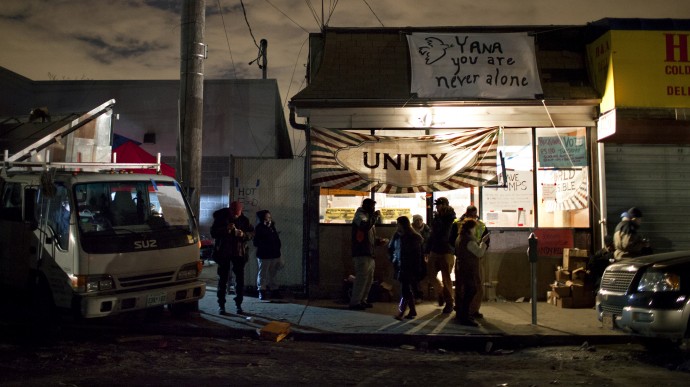
(NEW YORK) MintPress – If you go to Occupy Wall Street’s website these days, it’s all about Sandy. “We Got It,” screams a posting.
Indeed, in the past two weeks, Occupiers have set up a massive do-it-yourself response to the hurricane, helping victims in some of the hardest hit areas of New York City, many of whom are still without power, heat and hot water.
There are Occupy Sandy distribution sites at two churches in Brooklyn where hundreds of volunteers make hot meals and sort through piles of donated blankets, clothes and food. There is an Occupy pool of borrowed cars and pickup trucks that carries volunteers to the most ravaged areas. Occupy construction teams and medical committees have been formed.
«You see a need and you fulfill it,» explained 24-year-old Occupier Diego Ibanez. «There’s not a boss to tell you that you can’t do this or you can’t do that. It was one of the best trainings in how to mobilize so quickly.”
The Occupy movement began in September 2011 after Canadian anti-consumerist magazine Adbusters called for people to “flood into Lower Manhattan, set up tents, kitchens, peaceful barricades and occupy Wall Street” following the rise of the Arab Spring.
And they did, setting up a makeshift camp in lower Manhattan’s Zuccotti Park, which was soon followed by more than 100 others across the country and overseas.
But in mid-November 2011, the NYPD evicted everyone, arresting about 200 people in the process.
Without a home base, Occupy became less visible. Protesters often joined other projects, such as disrupting the auctions of foreclosed homes, opposing the construction of a natural gas pipeline under the Hudson River and planning a campaign to unify people affected by debt.
Now, the hurricane has given Occupiers a new sense of purpose and drive.
«This is young people making history,» said Mark Naison, a professor at Fordham University who has been studying Occupy Wall Street. «Young people who are refusing to let people suffer without putting themselves on the line to do something about it.»
Rising from the ashes
Occupy Sandy was initially the work of a small group of veterans of Zuccotti Park who, on the day after the storm, made their way to public housing projects in the Rockaways and Red Hook delivering flashlights and trays of hot lasagna to residents without power. They arranged for vans to help some people relocate to shelters.
The group then spent the night at St. Jacobi Evangelical Lutheran Church in Brooklyn. “They asked if they could crash here,” said Juan-Carlos Ruiz, a community organizer there who knew them from their previous work. “Those few bags became this enormous organic operation.”
A group of tech-savvy members now spend their days creating action plans and flow charts, and Occupiers use social media to spread the word.
A recent post on Occupy Sandy’s Facebook page announced: «Attention! If anyone in Rockaway needs to have their basement pumped, please contact Suzanne Hamalak at suzybklyn(at)aol.com. Her family wants to help and have industrial pumps … they will do it for free …»
“Adobo Medical Center in Red Hook needs an 8,000 watt generator AS SOON AS POSSIBLE,” read another.
While the local tech team sleeps, a shadow group in London works off-hours to update the Twitter feed and to maintain the Internet.
A group of Brooklyn residents affiliated with Occupy Sandy have even set up a wedding registry on Amazon.com, with a list of necessities, including cookware, small appliances, electronics, kitchen accessories, bed and bath supplies, and tools, hardware and outdoor living.
“Help donate to the victims of Hurricane Sandy by shipping items to the Occupy Sandy relief outpost at the Church of St. Luke and St. Matthew in Clinton Hill (520 Clinton Ave, Brooklyn, NY 11238),” it reads. “PLEASE pay for the most expedited shipping — these items are needed ASAP.”
«I think we wouldn’t be able to survive without them,» said Kathleen Ryan, a 54-year-old in Rockaway who was waiting for volunteers to retrieve her diabetes medication. “This community. They’ve helped a great deal.»
Fighting for the future
Occupiers are already seizing on their work during Sandy to gain momentum going forward.
“Even as we respond to the short-term crisis, we are building power from below and establishing networks of intensive care and mutual aid for the long-term,” reads a posting on the OWS website.
“In the coming months, we will see the People’s Bailout to abolish predatory debts; we will see the establishment of debt-clinics throughout the city; we will mobilize for an Eviction-Defense of the Earth of November 17th; we will see the Black Friday strike by workers and communities against Wal-Mart; we will see a People’s Reconstruction from Red Hook to Staten Island to Rockaways and beyond,” it continues.
Referring to corporate and government agencies, it says, “For them, the emergency is a temporary problem to be managed and administered in the name of restoring things to normal.
“But their normal was already a perpetual emergency for us—an emergency of economic inequality, debt-bondage, racial oppression, union-busting, municipal austerity, ecological destruction, police violence, historical amnesia, and more,” it adds. “We will not allow a return to normal.”


